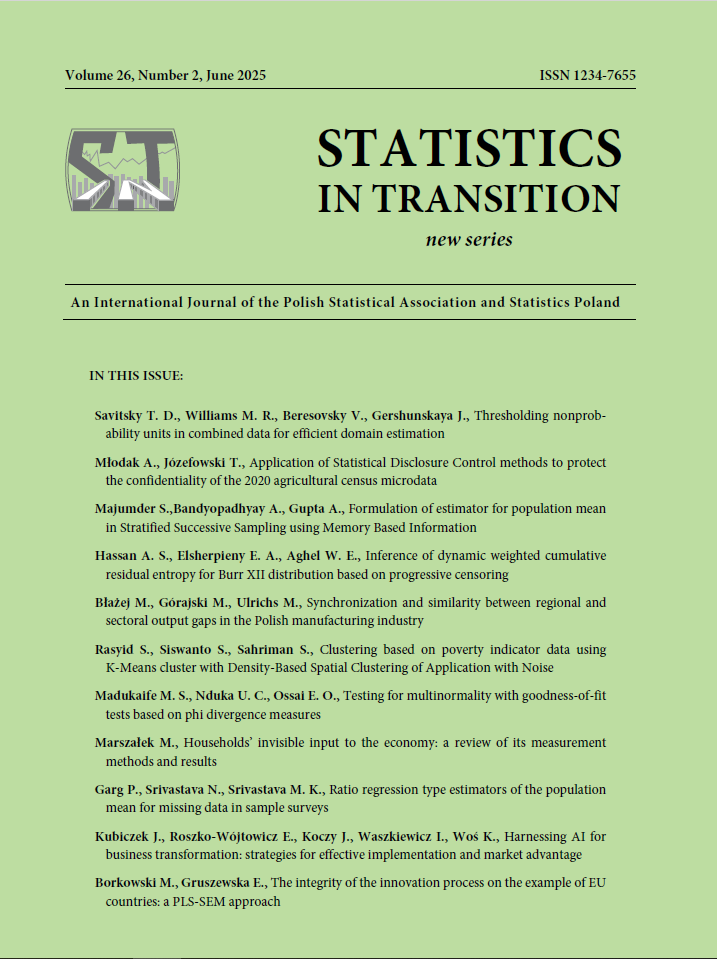ARTICLE
ABSTRACT
In this article, new ratio regression type estimators with imputation have been proposed as means to overcome the problem of missing data relating to a studied variable in a sample survey. It has been shown that the suggested estimators are more efficient than the mean method of imputation, the ratio method of imputation, the regression method of imputation, and the estimators given by Singh and Horn (2000), Singh and Deo (2003), Singh (2009), Diana and Perri (2010) and Gira (2015). The biases and their mean square errors of the suggested estimators are derived. A comparative study is conducted using real and simulated data. The results are found to be encouraging showing improvement of all the methods discussed in this article.
KEYWORDS
imputation methods, Bias, Mean square error (MSE), Efficiency, Ratio- Regression type estimators.
REFERENCES
Kadilar, C., Cingi, H., (2008). Estimators for the Population Mean in the Case of Missing Data. Communications in Statistics—Theory and Methods, 37, pp. 2226– 2236. http://dx.doi.org/10.1080/03610920701855020.
Diana, G., Perri, P. F., (2010). Improved Estimators of the Population Mean for Missing Data, Communications in Statistics—Theory and Methods, 39, pp. 3245–3251. http://dx.doi.org/10.1080/03610920903009400.
Gira, Abdeltawab, A., (2015). Estimation of population mean with a new imputation methods. Applied Mathematical Sciences, 9(34), pp. 1663–1672.
Chodjuntug K., Lawson, N., (2022). Imputation for estimating the population mean in the presence of nonresponse, with application to fine particle density in Bangkok. Mathematical Population Studies, 29(4), pp. 204–225.
Chodjuntug K., Lawson, N., (2022). A chain regression exponential type imputation method for mean estimation in the presence of missing data. Songklanakarin Journal of Science and Technology, 44(4), pp. 1109–1118.
Heitzan, D. F., Basu, S., (1996). Distinguishing ‘Missing at Random’ and ‘Missing Completely At Random’. The American Statistician, 50, pp. 207–213.
Kalton, G., Kasprzyk, D., (1982). Imputing for missing survey responses, In: Proceedings of the section on survey research method. American Statistical Association, pp. 22–31.
Kalton, G., Kasprzyk, D. and Santos, R., (1981). Issues of nonresponse and imputation in the survey of income and program participation, In: Krewski D, Platek R, Rao JNK (eds) Current topics in survey sampling. Academic Press, New York, pp. 455– 480.
Lee, H., Rancourt, E. and Särndal, C. E., (1994). Experiments with Variance Estimation from Survey Data with Imputed Values. Journal of Official Statistics, 10, pp. 231– 243.
Lee, H., Rancourt, E., Sarndal, C. E., (1995). Variance estimation in the presence of imputed data for the generalized estimation system. In: Proceedings of the section on survey research methods, American Statistical Association.
Murthy, M. N., (1967). Sampling theory and methods. Statistical publishing Society, Calcutta, India.
Lawson, N., (2023). New imputation method for estimating population mean in the presence of missing data. Lobachevskii Journal of Mathematics, 44(9), pp. 3740– 3748.
Lawson, N., (2023). A class of population mean estimators in the presence of missing data with applications to air pollution in Chiang Mai, Thailand. Lobachevskii Journal of Mathematics, 44(9), pp. 3749–3757.
Thongsak, N., Lawson, N., (2023). A new imputation method for population mean in the presence of missing data based on a transformed variable with applications to air pollution data in Chiang Mai, Thailand. Journal of Air Pollution and Health, 8(3), pp. 285–298.
Rao, J. N. K, Sitter, R. R., (1995). Variance Estimation under Two-Phase Sampling with Application to Imputation for Missing Data. Biometrika, 82, pp. 453–460. http://dx.doi.org/10.1093/biomet/82.2.453
Rubin, R. B., (1976). Inference and missing data. Biometrika, 63, pp. 581–592. http://dx.doi.org/10.1093/biomet/63.3.581
Singh, S., (2009). A new method of imputation in survey sampling. Statistics: A Journal of Theoretical and Applied Statistics, 43, pp. 499–511. http://dx.doi.org/10.1080/ 02331880802605114.
Singh, S., Deo, B., (2003). Imputation by Power Transformation. Statistical Papers, 44, pp. 555–579. http://dx.doi.org/10.1007/bf02926010.
Singh, S., Horn, S., (2000). Compromised Imputation in Survey Sampling. Metrika, 51, pp. 267–276. http://dx.doi.org/10.1007/s001840000054.
Srivenkataramana, T., Tracy, D. S., (1980). An Alternative to Ratio Method in Sample Surveys. Annals of the Institute of Statistical Mathematics, 32, pp. 111–120. http://dx.doi.org/10.1007/ bf02480317.
